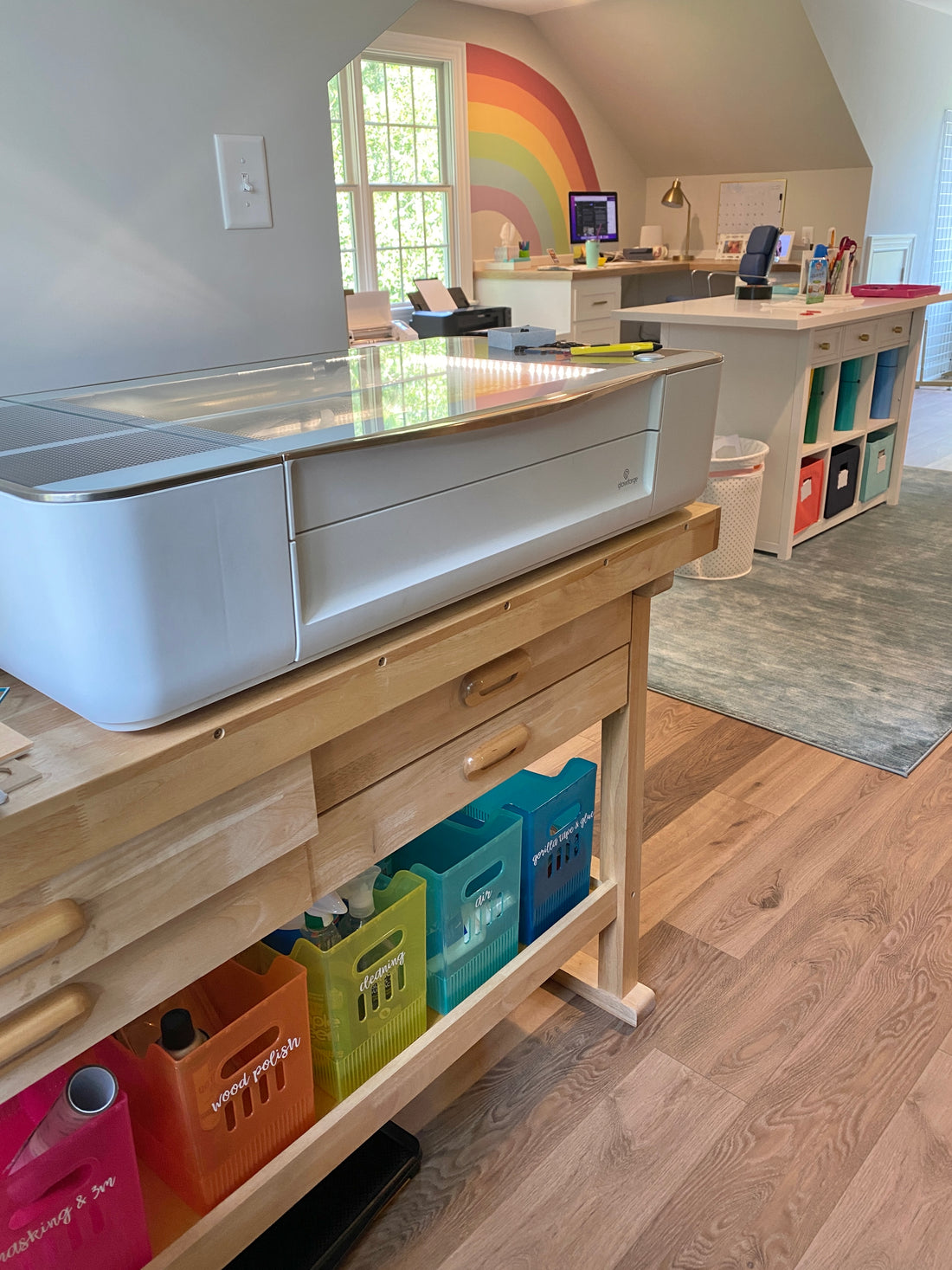If you've been around the crafting world, you've probably heard the word Glowforge mentioned and maybe even seen some of the amazing projects that come out of it! So what is it? A printer? Nope (despite Glowforge themselves confusingly referring to it as a printer). A 3D printer? No, again. 3D printers use a filament in many layers to create an object. The Glowforge is a laser and the beam of light literally burns and takes away from the material you put into it.
HOW DOES IT WORK?
Glowforge is a CO2 laser. Electricity is run through a glass tube filled with carbon dioxide, which produces a beam of light the width of a human hair. This laser beam is used to cut or engrave a variety of materials.
Simply place your material (up to 12″ x 20″) in the bed of the Glowforge on the honeycomb tray. This can be acrylic, wood, cardboard, leather (vegetable tanned only), fabric, and so many other things, even food! You can buy “proofgrade” materials straight from Glowforge, which basically means they’re approved to work perfectly with their settings, and the boards have handy QR codes the Glowforge will scan and detect the material. But you’ll save A LOT of money by finding other sources for your materials, maybe even a small business local to you. Lasered By The Creek is my go-to for wood, and Custom Made Better has every possible acrylic you could look for. Click this link to save 10% off your first order of acrylic!
With your material in place, you will send your design, saved as an SVG (scalable vector graphic), to the Glowforge via wifi. I personally use Silhouette Design Studio Business Edition to design and create SVGs. A lot of people use Illustrator, Corel Draw or Lightburn. The program doesn’t really matter, as long as you can save as SVG. You can even buy pre-made SVGs from places like Etsy or Creative Market. You can cut shapes or engrave designs, or both! Here’s a little time-lapse video of me engraving and cutting some race medals out of wood.
IS IT EASY TO SET UP?
Yes! As far as lasers go, the Glowforge is about as easy as it gets to set up. It has a pretty small footprint for a laser, about 38″ wide, 22″ deep and 8″ tall and weighs about 50 lbs. So you can easily put it in your craft room on a nice, sturdy table.
You will go through some steps to register it and get it connected to your wifi, and then you’re pretty much good to go… except, venting…
VENTING
 As the laser burns away layers of wood or acrylic, you need that dust to go somewhere, and you sure don’t want it hanging out in your room! You need to decide how to best vent the laser. Glowforge does sell a compact filter, but I’ve not used it. I’ve only heard how expensive the filters are to replace and how quickly you will go through them. To me, the best option is to vent out a window. You just need some 4 inch ducting (I use a 4 layer ducting to prevent leaks). Connect one end to the back of the Glowforge and the other one can literally hang out your window, or you can get fancy like me and get a window dryer vent to connect the other end to, and then you simply take that in and out of the window as needed. Just be sure to seal up the connections really well with foil tape.
As the laser burns away layers of wood or acrylic, you need that dust to go somewhere, and you sure don’t want it hanging out in your room! You need to decide how to best vent the laser. Glowforge does sell a compact filter, but I’ve not used it. I’ve only heard how expensive the filters are to replace and how quickly you will go through them. To me, the best option is to vent out a window. You just need some 4 inch ducting (I use a 4 layer ducting to prevent leaks). Connect one end to the back of the Glowforge and the other one can literally hang out your window, or you can get fancy like me and get a window dryer vent to connect the other end to, and then you simply take that in and out of the window as needed. Just be sure to seal up the connections really well with foil tape.
WHICH GLOWFORGE SHOULD I GET?
There are 3 different Glowforge models: the Basic, Plus and Pro. I currently have the Basic and it has been amazing for me and my small business over the last 3.5 years. Here’s the breakdown of each model:
Basic: 40 watts, 6 month warranty.
Plus: 40 watts, 12 month warranty with claims that it cuts up to twice as fast as the basic (I cannot confirm this).
Pro: 45 watts, so this one’s a little more powerful, but the biggest feature is a passthrough slot that allows you to cut longer materials. 12 month warranty. Glowforge says the Pro can cut up to three times faster than the Basic, but again, I’ve only used the Basic, so I cannot confirm this.
WHAT ELSE DO I NEED TO KNOW?
Here are some other tips and things to keep in mind if you are considering investing in a Glowforge…
- Do your research on what you put into your Glowforge. While it’s tempting to try to cut or engrave everything, not everything is laser safe. Make sure you aren’t releasing harmful chemicals. Faux leather is an example of something NOT to cut, as well as most colored leather, which is chemically treated.
- If you do want to engrave on food items, you will need to have a separate Glowforge just to do this. Please don’t mix sawdust and cupcakes!
- The Glowforge does not engrave metal. You can spray CerMark on metal and mark it, but it won’t actually engrave into the metal.
- You will want to mask (with paper masking, not plastic) most material to protect it from flashback or discoloration from the laser. The easiest way I’ve found to peel masking off is with Gorilla tape!
- You can engrave something thicker, like a cutting board, by removing the honeycomb tray.
- The Glowforge does NOT engrave cups. Up to 2″ thick.
- Keep a fire blanket and fire extinguisher nearby, just in case. NEVER leave your Glowforge running unattended. Also keep in mind a regular fire extinguisher might stop the fire but will ruin electronics. Worth the extra cost to buy a Halotron Class B or C fire extinguisher.
- Don’t use alcohol on acrylic – it can cause crazing or cracking. I find acetone to work great, as well as the Novus cleaners.
- Always do a test cut! (No one wants to waste materials.)
WANT A DISCOUNT ON A GLOWFORGE?
Who doesn’t love a discount?! Using my referral link, you can save up to $500 on a Glowforge!
If you have any questions, feel free to leave them in the comments and I am happy to help answer them. Please also let me know what you’d like to see or learn about in future blog posts!
Happy lasering!

